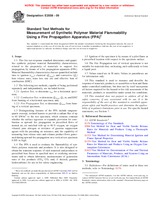We need your consent to use the individual data so that you can see information about your interests, among other things. Click "OK" to give your consent.
ASTM E2058-09
Standard Test Methods for Measurement of Synthetic Polymer Material Flammability Using a Fire Propagation Apparatus (FPA)
STANDARD published on 1.4.2009
The information about the standard:
Designation standards: ASTM E2058-09
Note: WITHDRAWN
Publication date standards: 1.4.2009
SKU: NS-44132
The number of pages: 31
Approximate weight : 93 g (0.21 lbs)
Country: American technical standard
Category: Technical standards ASTM
Annotation of standard text ASTM E2058-09 :
Keywords:
effective heat of combustion, fire propagation apparatus, flammability characteristics, upward fire propagation, Fire propagation apparatus (FPA), Flammability--plastics, Polymers, Synthetic polymers, ICS Number Code 13.220.40 (Ignitability and burning behaviour of materials and products), 59.060.20 (Man-made fibres)
Additional information
| Significance and Use | ||||||||||
|
These test methods are an integral part of existing test standards for cable fire propagation and clean room material flammability, as well as, in an approval standard for conveyor belting (1-3). Refs (1-3) use these test methods because fire-test-response results obtained from the test methods correlate with fire behavior during real-scale fire propagation tests, as discussed in X1.4 The Ignition, Combustion, or Fire Propagation test method, or a combination thereof, have been performed with materials and products containing a wide range of polymer compositions and structures, as described in X1.7. The Fire Propagation test method is different from the test methods in the ASTM standards listed in 2.1 by virtue of producing laboratory measurements of the chemical heat release rate during upward fire propagation and burning on a vertical test specimen in normal air, oxygen-enriched air, or in oxygen-vitiated air. Test methods from other standards, for example, Test Method E 1321, which yields measurements during lateral/horizontal or downward flame spread on materials and Test Methods E 906, E 1354, and E 1623, which yield measurements of the rate of heat release from materials fully involved in flaming combustion, generally use an external radiant flux, rather than the flames from the burning material itself, to characterize fire behavior. These test methods are not intended to be routine quality control tests. They are intended for evaluation of specific flammability characteristics of materials. Materials to be analyzed consist of specimens from an end-use product or the various components used in the end-use product. Results from the laboratory procedures provide input to fire propagation and fire growth models, risk analysis studies, building and product designs, and materials research and development. |
||||||||||
| 1. Scope | ||||||||||
|
1.1 This fire-test-response standard determines and quantifies synthetic polymer material flammability characteristics, related to the propensity of materials to support fire propagation, by means of a fire propagation apparatus (FPA). Material flammability characteristics that are quantified include time to ignition (tign), chemical ( ˙Qchem), and convective ( ˙Qc) heat release rates, mass loss rate ( ˙m) and effective heat of combustion (EHC). 1.2 The following test methods, capable of being performed separately and independently, are included herein: 1.2.1 Ignition Test, to determine tign for a horizontal specimen; 1.2.2 Combustion Test, to determine ˙Qchem, ˙Qc, ˙m, and EHC from burning of a horizontal specimen; and, 1.2.3 Fire Propagation Test, to determine ˙Qchem from burning of a vertical specimen. 1.3 Distinguishing features of the FPA include tungsten-quartz external, isolated heaters to provide a radiant flux of up to 65 kW/m2 to the test specimen, which remains constant whether the surface regresses or expands; provision for combustion or upward fire propagation in prescribed flows of normal air, air enriched with up to 40 % oxygen, air oxygen vitiated, pure nitrogen or mixtures of gaseous suppression agents with the preceding air mixtures; and, the capability of measuring heat release rates and exhaust product flows generated during upward fire propagation on a vertical test specimen 0.305 m high. 1.4 The FPA is used to evaluate the flammability of synthetic polymer materials and products. It is also designed to obtain the transient response of such materials and products to prescribed heat fluxes in specified inert or oxidizing environments and to obtain laboratory measurements of generation rates of fire products (CO2, CO, and, if desired, gaseous hydrocarbons) for use in fire safety engineering. 1.5 Ignition of the specimen is by means of a pilot flame at a prescribed location with respect to the specimen surface. 1.6 The Fire Propagation test of vertical specimens is not suitable for materials that, on heating, melt sufficiently to form a liquid pool. 1.7 Values stated are in SI units. Values in parentheses are for information only. 1.8 This standard is used to measure and describe the response of materials, products, or assemblies to heat and flame under controlled conditions, but does not by itself incorporate all factors required for fire hazard or fire risk assessment of the materials, products or assemblies under actual fire conditions. 1.9 This standard does not purport to address all of the safety concerns, if any, associated with its use. It is the responsibility of the user of this standard to establish appropriate safety and health practices and determine the applicability of regulatory limitations prior to use. For specific hazard statements, see Section 7. |
||||||||||
| 2. Referenced Documents | ||||||||||
|
We recommend:
Technical standards updating
Do you want to make sure you use only the valid technical standards?
We can offer you a solution which will provide you a monthly overview concerning the updating of standards which you use.
Would you like to know more? Look at this page.




 Cookies
Cookies
